FELM4026 - Financial and Economic Literacy for Managers - Autumn
VerifiedAdded on 2023/05/30
|10
|3085
|104
Homework Assignment
AI Summary
This assignment delves into financial and economic literacy for managers, exploring the interplay between internal and external business environments, using examples like supermarkets and global retailers like Walmart. It analyzes Walmart's sales performance, strategic initiatives, and the impact of e-commerce. The assignment also discusses economic theories of price adjustment in response to demand and supply shocks, with practical applications to businesses like McDonald's and Tesco. Furthermore, it examines the role of financial intermediaries such as banks, credit unions, collective investment schemes, and insurance companies in providing financial resources to businesses, particularly in the retail industry, highlighting the challenges faced by smaller companies in accessing funding and alternative financing options available to them. This document is available on Desklib, a platform offering a wealth of study resources and past papers to support students.
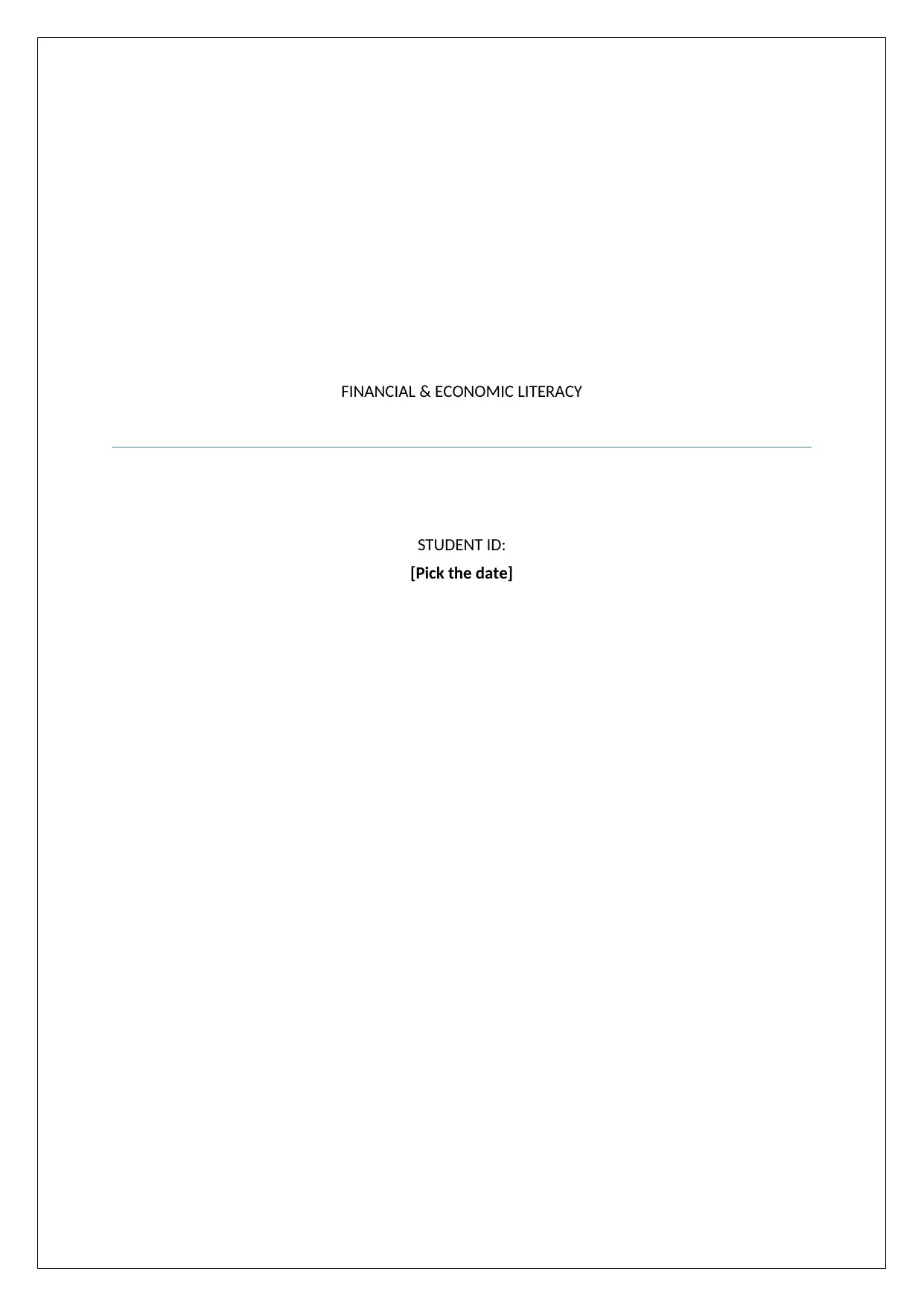
FINANCIAL & ECONOMIC LITERACY
STUDENT ID:
[Pick the date]
STUDENT ID:
[Pick the date]
Paraphrase This Document
Need a fresh take? Get an instant paraphrase of this document with our AI Paraphraser
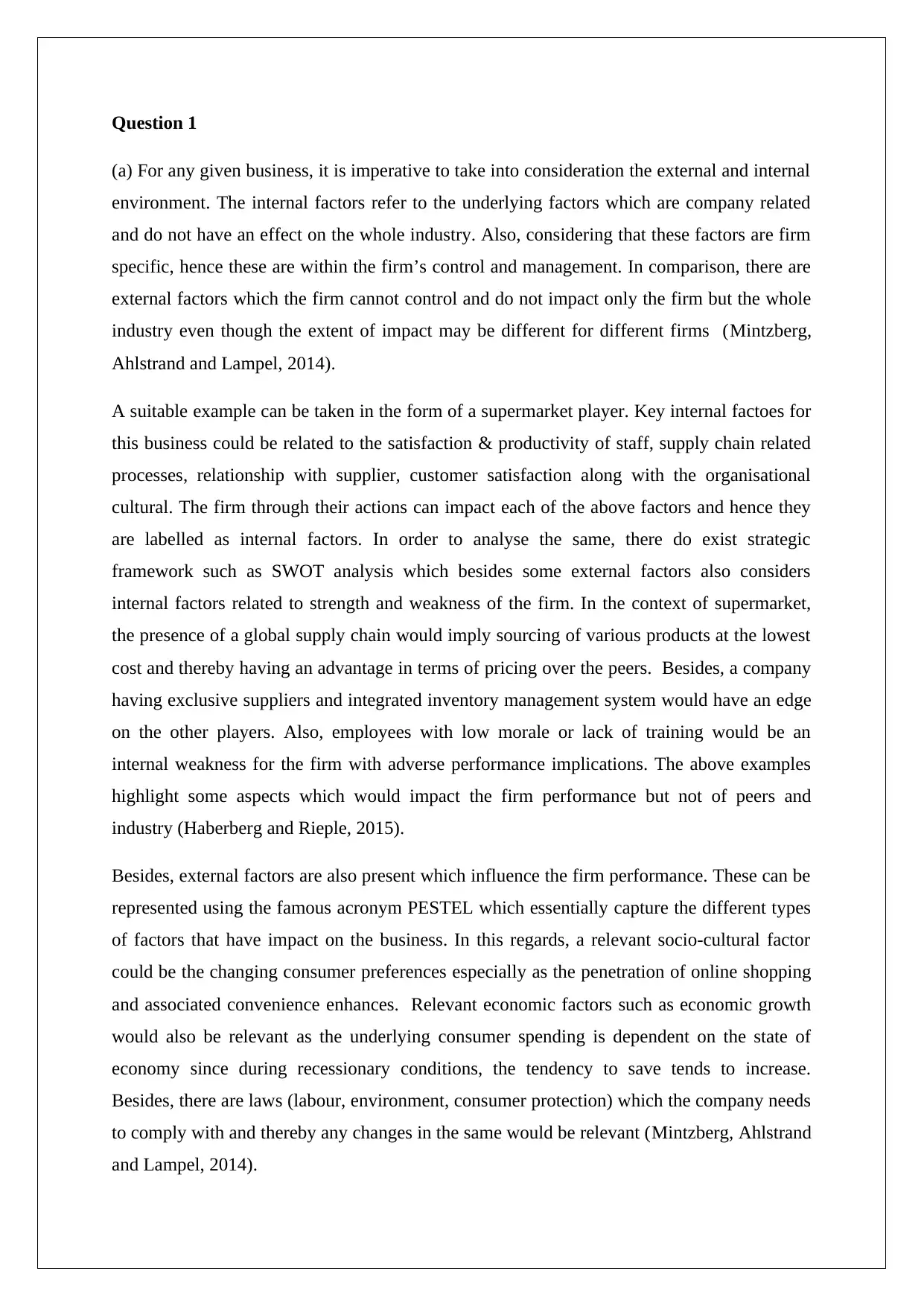
Question 1
(a) For any given business, it is imperative to take into consideration the external and internal
environment. The internal factors refer to the underlying factors which are company related
and do not have an effect on the whole industry. Also, considering that these factors are firm
specific, hence these are within the firm’s control and management. In comparison, there are
external factors which the firm cannot control and do not impact only the firm but the whole
industry even though the extent of impact may be different for different firms (Mintzberg,
Ahlstrand and Lampel, 2014).
A suitable example can be taken in the form of a supermarket player. Key internal factoes for
this business could be related to the satisfaction & productivity of staff, supply chain related
processes, relationship with supplier, customer satisfaction along with the organisational
cultural. The firm through their actions can impact each of the above factors and hence they
are labelled as internal factors. In order to analyse the same, there do exist strategic
framework such as SWOT analysis which besides some external factors also considers
internal factors related to strength and weakness of the firm. In the context of supermarket,
the presence of a global supply chain would imply sourcing of various products at the lowest
cost and thereby having an advantage in terms of pricing over the peers. Besides, a company
having exclusive suppliers and integrated inventory management system would have an edge
on the other players. Also, employees with low morale or lack of training would be an
internal weakness for the firm with adverse performance implications. The above examples
highlight some aspects which would impact the firm performance but not of peers and
industry (Haberberg and Rieple, 2015).
Besides, external factors are also present which influence the firm performance. These can be
represented using the famous acronym PESTEL which essentially capture the different types
of factors that have impact on the business. In this regards, a relevant socio-cultural factor
could be the changing consumer preferences especially as the penetration of online shopping
and associated convenience enhances. Relevant economic factors such as economic growth
would also be relevant as the underlying consumer spending is dependent on the state of
economy since during recessionary conditions, the tendency to save tends to increase.
Besides, there are laws (labour, environment, consumer protection) which the company needs
to comply with and thereby any changes in the same would be relevant (Mintzberg, Ahlstrand
and Lampel, 2014).
(a) For any given business, it is imperative to take into consideration the external and internal
environment. The internal factors refer to the underlying factors which are company related
and do not have an effect on the whole industry. Also, considering that these factors are firm
specific, hence these are within the firm’s control and management. In comparison, there are
external factors which the firm cannot control and do not impact only the firm but the whole
industry even though the extent of impact may be different for different firms (Mintzberg,
Ahlstrand and Lampel, 2014).
A suitable example can be taken in the form of a supermarket player. Key internal factoes for
this business could be related to the satisfaction & productivity of staff, supply chain related
processes, relationship with supplier, customer satisfaction along with the organisational
cultural. The firm through their actions can impact each of the above factors and hence they
are labelled as internal factors. In order to analyse the same, there do exist strategic
framework such as SWOT analysis which besides some external factors also considers
internal factors related to strength and weakness of the firm. In the context of supermarket,
the presence of a global supply chain would imply sourcing of various products at the lowest
cost and thereby having an advantage in terms of pricing over the peers. Besides, a company
having exclusive suppliers and integrated inventory management system would have an edge
on the other players. Also, employees with low morale or lack of training would be an
internal weakness for the firm with adverse performance implications. The above examples
highlight some aspects which would impact the firm performance but not of peers and
industry (Haberberg and Rieple, 2015).
Besides, external factors are also present which influence the firm performance. These can be
represented using the famous acronym PESTEL which essentially capture the different types
of factors that have impact on the business. In this regards, a relevant socio-cultural factor
could be the changing consumer preferences especially as the penetration of online shopping
and associated convenience enhances. Relevant economic factors such as economic growth
would also be relevant as the underlying consumer spending is dependent on the state of
economy since during recessionary conditions, the tendency to save tends to increase.
Besides, there are laws (labour, environment, consumer protection) which the company needs
to comply with and thereby any changes in the same would be relevant (Mintzberg, Ahlstrand
and Lampel, 2014).
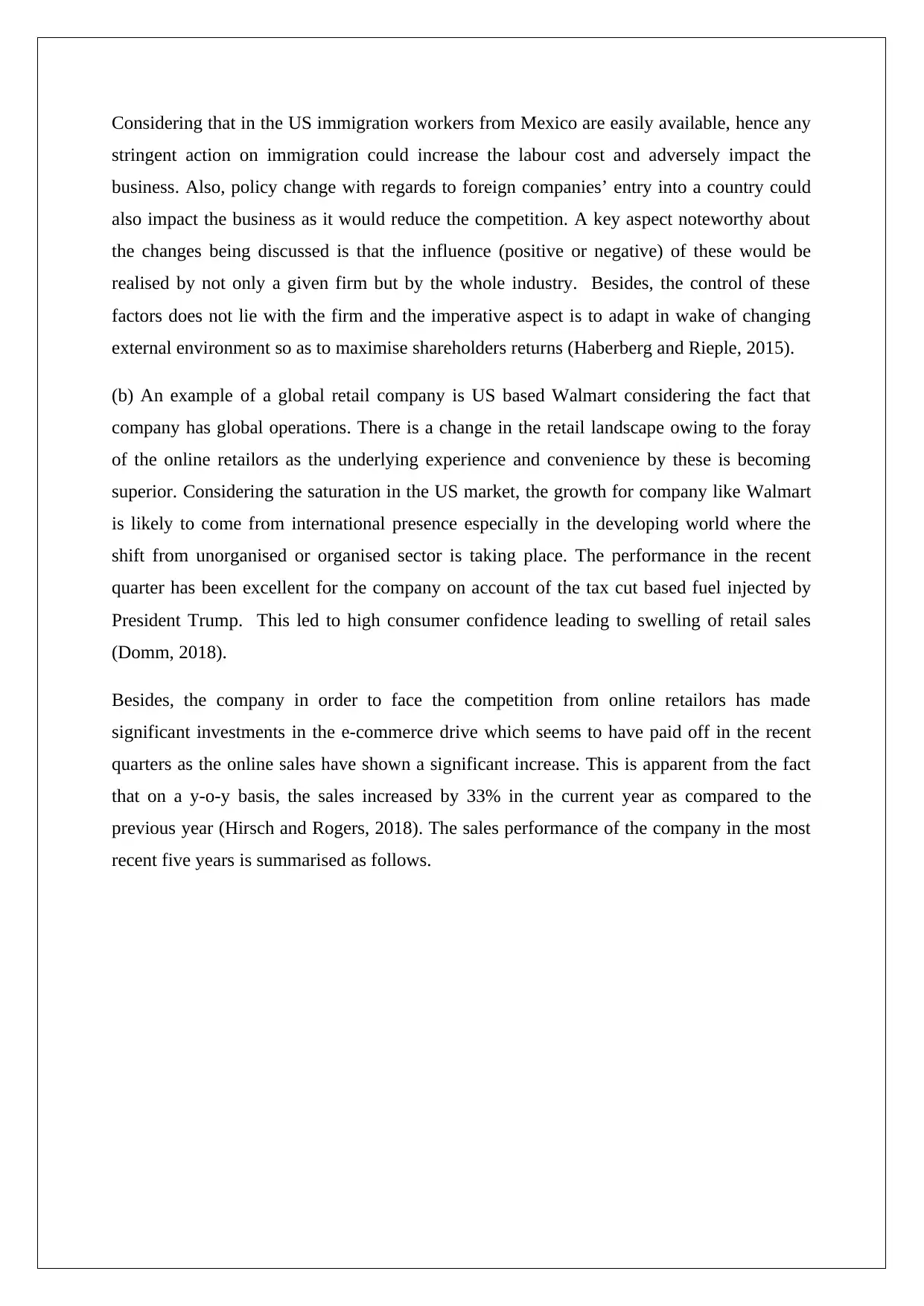
Considering that in the US immigration workers from Mexico are easily available, hence any
stringent action on immigration could increase the labour cost and adversely impact the
business. Also, policy change with regards to foreign companies’ entry into a country could
also impact the business as it would reduce the competition. A key aspect noteworthy about
the changes being discussed is that the influence (positive or negative) of these would be
realised by not only a given firm but by the whole industry. Besides, the control of these
factors does not lie with the firm and the imperative aspect is to adapt in wake of changing
external environment so as to maximise shareholders returns (Haberberg and Rieple, 2015).
(b) An example of a global retail company is US based Walmart considering the fact that
company has global operations. There is a change in the retail landscape owing to the foray
of the online retailors as the underlying experience and convenience by these is becoming
superior. Considering the saturation in the US market, the growth for company like Walmart
is likely to come from international presence especially in the developing world where the
shift from unorganised or organised sector is taking place. The performance in the recent
quarter has been excellent for the company on account of the tax cut based fuel injected by
President Trump. This led to high consumer confidence leading to swelling of retail sales
(Domm, 2018).
Besides, the company in order to face the competition from online retailors has made
significant investments in the e-commerce drive which seems to have paid off in the recent
quarters as the online sales have shown a significant increase. This is apparent from the fact
that on a y-o-y basis, the sales increased by 33% in the current year as compared to the
previous year (Hirsch and Rogers, 2018). The sales performance of the company in the most
recent five years is summarised as follows.
stringent action on immigration could increase the labour cost and adversely impact the
business. Also, policy change with regards to foreign companies’ entry into a country could
also impact the business as it would reduce the competition. A key aspect noteworthy about
the changes being discussed is that the influence (positive or negative) of these would be
realised by not only a given firm but by the whole industry. Besides, the control of these
factors does not lie with the firm and the imperative aspect is to adapt in wake of changing
external environment so as to maximise shareholders returns (Haberberg and Rieple, 2015).
(b) An example of a global retail company is US based Walmart considering the fact that
company has global operations. There is a change in the retail landscape owing to the foray
of the online retailors as the underlying experience and convenience by these is becoming
superior. Considering the saturation in the US market, the growth for company like Walmart
is likely to come from international presence especially in the developing world where the
shift from unorganised or organised sector is taking place. The performance in the recent
quarter has been excellent for the company on account of the tax cut based fuel injected by
President Trump. This led to high consumer confidence leading to swelling of retail sales
(Domm, 2018).
Besides, the company in order to face the competition from online retailors has made
significant investments in the e-commerce drive which seems to have paid off in the recent
quarters as the online sales have shown a significant increase. This is apparent from the fact
that on a y-o-y basis, the sales increased by 33% in the current year as compared to the
previous year (Hirsch and Rogers, 2018). The sales performance of the company in the most
recent five years is summarised as follows.
⊘ This is a preview!⊘
Do you want full access?
Subscribe today to unlock all pages.

Trusted by 1+ million students worldwide
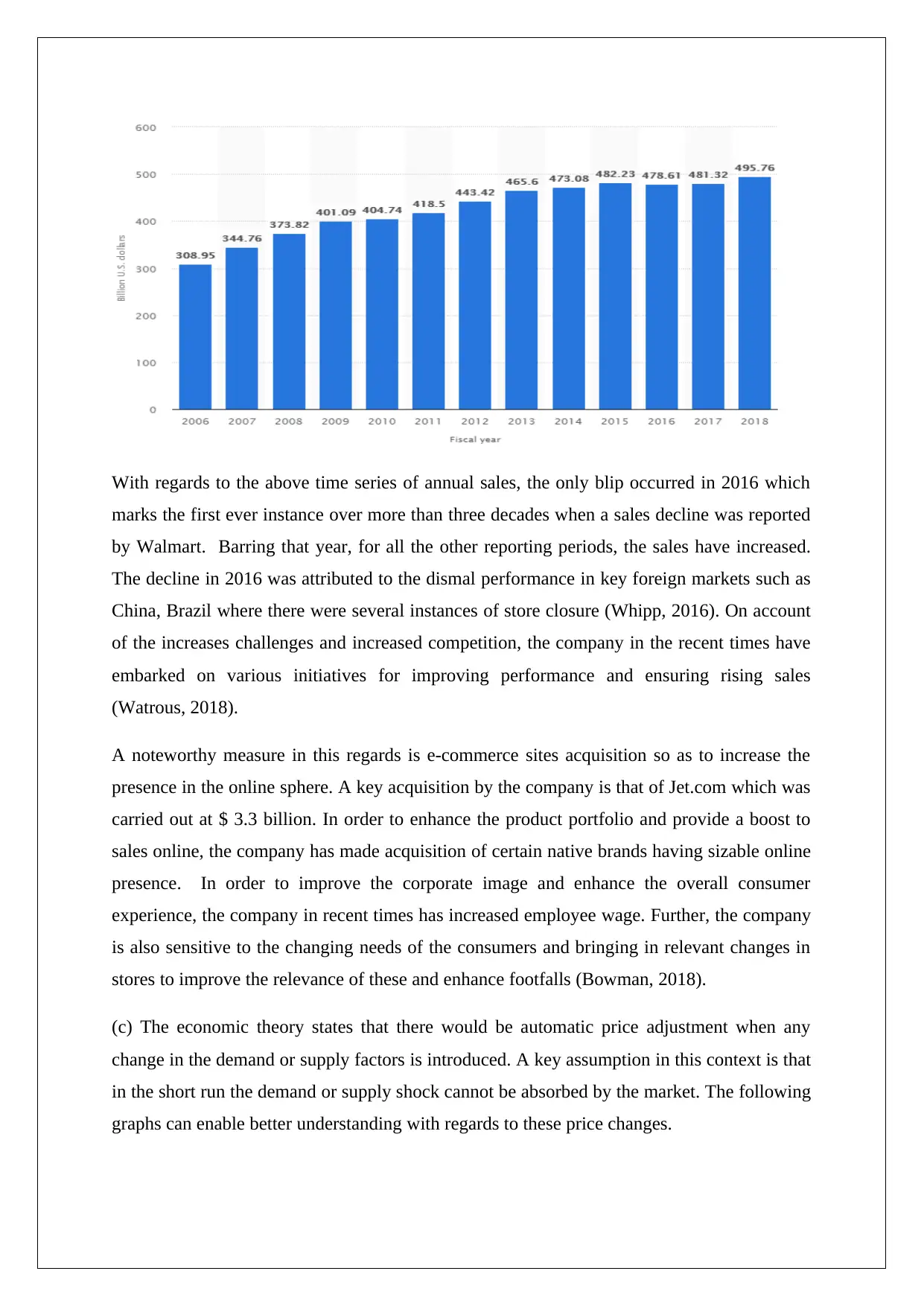
With regards to the above time series of annual sales, the only blip occurred in 2016 which
marks the first ever instance over more than three decades when a sales decline was reported
by Walmart. Barring that year, for all the other reporting periods, the sales have increased.
The decline in 2016 was attributed to the dismal performance in key foreign markets such as
China, Brazil where there were several instances of store closure (Whipp, 2016). On account
of the increases challenges and increased competition, the company in the recent times have
embarked on various initiatives for improving performance and ensuring rising sales
(Watrous, 2018).
A noteworthy measure in this regards is e-commerce sites acquisition so as to increase the
presence in the online sphere. A key acquisition by the company is that of Jet.com which was
carried out at $ 3.3 billion. In order to enhance the product portfolio and provide a boost to
sales online, the company has made acquisition of certain native brands having sizable online
presence. In order to improve the corporate image and enhance the overall consumer
experience, the company in recent times has increased employee wage. Further, the company
is also sensitive to the changing needs of the consumers and bringing in relevant changes in
stores to improve the relevance of these and enhance footfalls (Bowman, 2018).
(c) The economic theory states that there would be automatic price adjustment when any
change in the demand or supply factors is introduced. A key assumption in this context is that
in the short run the demand or supply shock cannot be absorbed by the market. The following
graphs can enable better understanding with regards to these price changes.
marks the first ever instance over more than three decades when a sales decline was reported
by Walmart. Barring that year, for all the other reporting periods, the sales have increased.
The decline in 2016 was attributed to the dismal performance in key foreign markets such as
China, Brazil where there were several instances of store closure (Whipp, 2016). On account
of the increases challenges and increased competition, the company in the recent times have
embarked on various initiatives for improving performance and ensuring rising sales
(Watrous, 2018).
A noteworthy measure in this regards is e-commerce sites acquisition so as to increase the
presence in the online sphere. A key acquisition by the company is that of Jet.com which was
carried out at $ 3.3 billion. In order to enhance the product portfolio and provide a boost to
sales online, the company has made acquisition of certain native brands having sizable online
presence. In order to improve the corporate image and enhance the overall consumer
experience, the company in recent times has increased employee wage. Further, the company
is also sensitive to the changing needs of the consumers and bringing in relevant changes in
stores to improve the relevance of these and enhance footfalls (Bowman, 2018).
(c) The economic theory states that there would be automatic price adjustment when any
change in the demand or supply factors is introduced. A key assumption in this context is that
in the short run the demand or supply shock cannot be absorbed by the market. The following
graphs can enable better understanding with regards to these price changes.
Paraphrase This Document
Need a fresh take? Get an instant paraphrase of this document with our AI Paraphraser
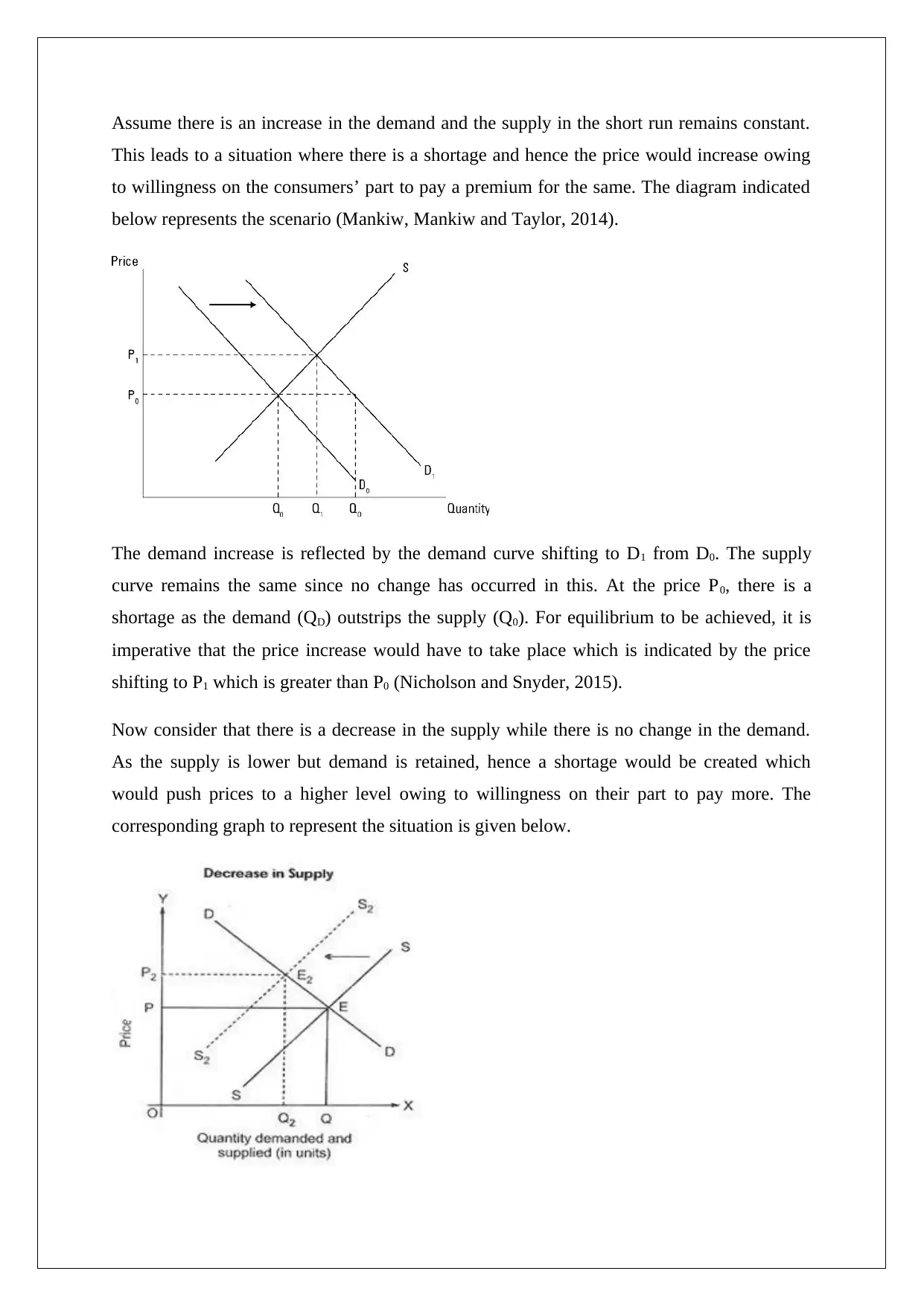
Assume there is an increase in the demand and the supply in the short run remains constant.
This leads to a situation where there is a shortage and hence the price would increase owing
to willingness on the consumers’ part to pay a premium for the same. The diagram indicated
below represents the scenario (Mankiw, Mankiw and Taylor, 2014).
The demand increase is reflected by the demand curve shifting to D1 from D0. The supply
curve remains the same since no change has occurred in this. At the price P0, there is a
shortage as the demand (QD) outstrips the supply (Q0). For equilibrium to be achieved, it is
imperative that the price increase would have to take place which is indicated by the price
shifting to P1 which is greater than P0 (Nicholson and Snyder, 2015).
Now consider that there is a decrease in the supply while there is no change in the demand.
As the supply is lower but demand is retained, hence a shortage would be created which
would push prices to a higher level owing to willingness on their part to pay more. The
corresponding graph to represent the situation is given below.
This leads to a situation where there is a shortage and hence the price would increase owing
to willingness on the consumers’ part to pay a premium for the same. The diagram indicated
below represents the scenario (Mankiw, Mankiw and Taylor, 2014).
The demand increase is reflected by the demand curve shifting to D1 from D0. The supply
curve remains the same since no change has occurred in this. At the price P0, there is a
shortage as the demand (QD) outstrips the supply (Q0). For equilibrium to be achieved, it is
imperative that the price increase would have to take place which is indicated by the price
shifting to P1 which is greater than P0 (Nicholson and Snyder, 2015).
Now consider that there is a decrease in the supply while there is no change in the demand.
As the supply is lower but demand is retained, hence a shortage would be created which
would push prices to a higher level owing to willingness on their part to pay more. The
corresponding graph to represent the situation is given below.
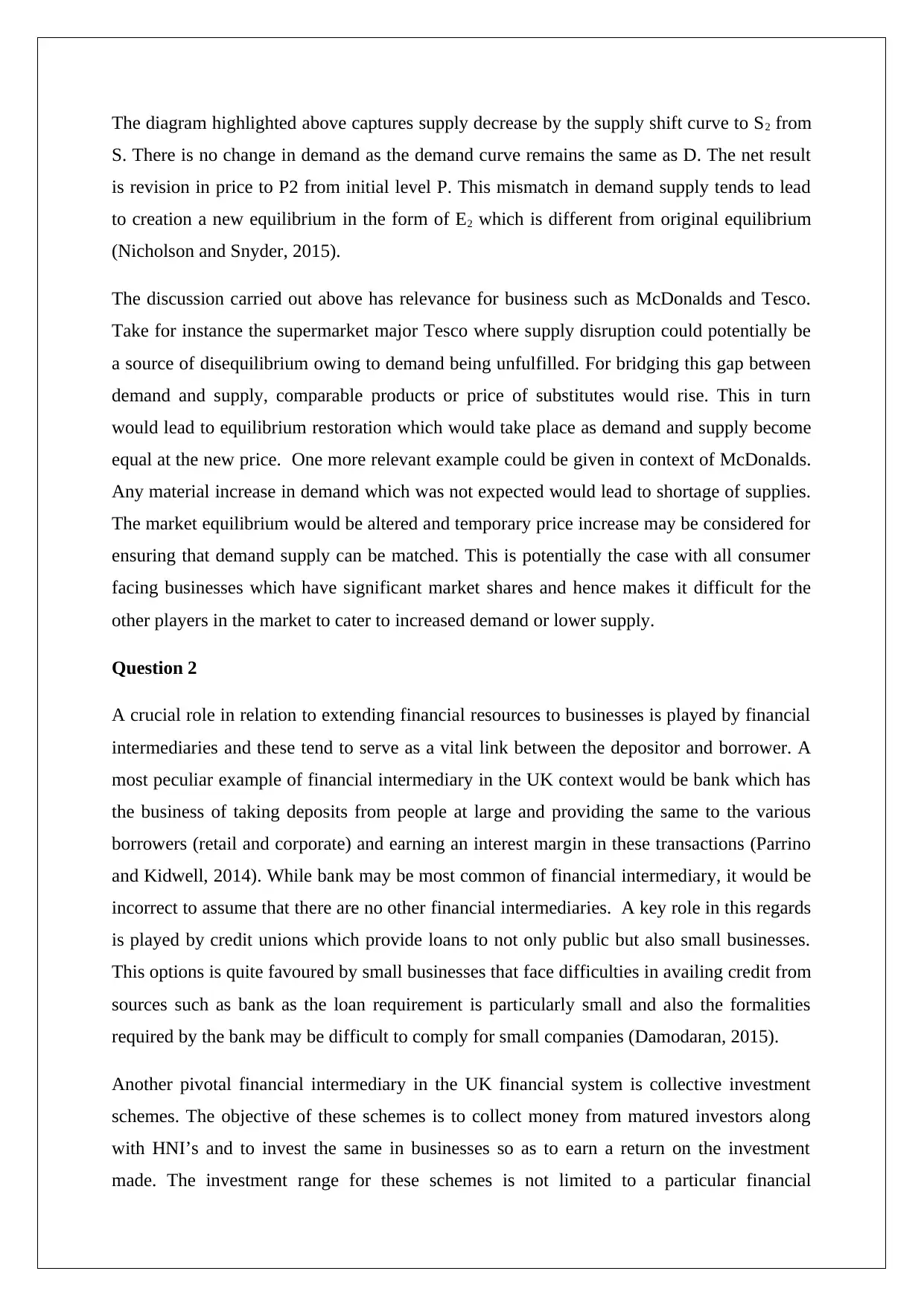
The diagram highlighted above captures supply decrease by the supply shift curve to S2 from
S. There is no change in demand as the demand curve remains the same as D. The net result
is revision in price to P2 from initial level P. This mismatch in demand supply tends to lead
to creation a new equilibrium in the form of E2 which is different from original equilibrium
(Nicholson and Snyder, 2015).
The discussion carried out above has relevance for business such as McDonalds and Tesco.
Take for instance the supermarket major Tesco where supply disruption could potentially be
a source of disequilibrium owing to demand being unfulfilled. For bridging this gap between
demand and supply, comparable products or price of substitutes would rise. This in turn
would lead to equilibrium restoration which would take place as demand and supply become
equal at the new price. One more relevant example could be given in context of McDonalds.
Any material increase in demand which was not expected would lead to shortage of supplies.
The market equilibrium would be altered and temporary price increase may be considered for
ensuring that demand supply can be matched. This is potentially the case with all consumer
facing businesses which have significant market shares and hence makes it difficult for the
other players in the market to cater to increased demand or lower supply.
Question 2
A crucial role in relation to extending financial resources to businesses is played by financial
intermediaries and these tend to serve as a vital link between the depositor and borrower. A
most peculiar example of financial intermediary in the UK context would be bank which has
the business of taking deposits from people at large and providing the same to the various
borrowers (retail and corporate) and earning an interest margin in these transactions (Parrino
and Kidwell, 2014). While bank may be most common of financial intermediary, it would be
incorrect to assume that there are no other financial intermediaries. A key role in this regards
is played by credit unions which provide loans to not only public but also small businesses.
This options is quite favoured by small businesses that face difficulties in availing credit from
sources such as bank as the loan requirement is particularly small and also the formalities
required by the bank may be difficult to comply for small companies (Damodaran, 2015).
Another pivotal financial intermediary in the UK financial system is collective investment
schemes. The objective of these schemes is to collect money from matured investors along
with HNI’s and to invest the same in businesses so as to earn a return on the investment
made. The investment range for these schemes is not limited to a particular financial
S. There is no change in demand as the demand curve remains the same as D. The net result
is revision in price to P2 from initial level P. This mismatch in demand supply tends to lead
to creation a new equilibrium in the form of E2 which is different from original equilibrium
(Nicholson and Snyder, 2015).
The discussion carried out above has relevance for business such as McDonalds and Tesco.
Take for instance the supermarket major Tesco where supply disruption could potentially be
a source of disequilibrium owing to demand being unfulfilled. For bridging this gap between
demand and supply, comparable products or price of substitutes would rise. This in turn
would lead to equilibrium restoration which would take place as demand and supply become
equal at the new price. One more relevant example could be given in context of McDonalds.
Any material increase in demand which was not expected would lead to shortage of supplies.
The market equilibrium would be altered and temporary price increase may be considered for
ensuring that demand supply can be matched. This is potentially the case with all consumer
facing businesses which have significant market shares and hence makes it difficult for the
other players in the market to cater to increased demand or lower supply.
Question 2
A crucial role in relation to extending financial resources to businesses is played by financial
intermediaries and these tend to serve as a vital link between the depositor and borrower. A
most peculiar example of financial intermediary in the UK context would be bank which has
the business of taking deposits from people at large and providing the same to the various
borrowers (retail and corporate) and earning an interest margin in these transactions (Parrino
and Kidwell, 2014). While bank may be most common of financial intermediary, it would be
incorrect to assume that there are no other financial intermediaries. A key role in this regards
is played by credit unions which provide loans to not only public but also small businesses.
This options is quite favoured by small businesses that face difficulties in availing credit from
sources such as bank as the loan requirement is particularly small and also the formalities
required by the bank may be difficult to comply for small companies (Damodaran, 2015).
Another pivotal financial intermediary in the UK financial system is collective investment
schemes. The objective of these schemes is to collect money from matured investors along
with HNI’s and to invest the same in businesses so as to earn a return on the investment
made. The investment range for these schemes is not limited to a particular financial
⊘ This is a preview!⊘
Do you want full access?
Subscribe today to unlock all pages.

Trusted by 1+ million students worldwide
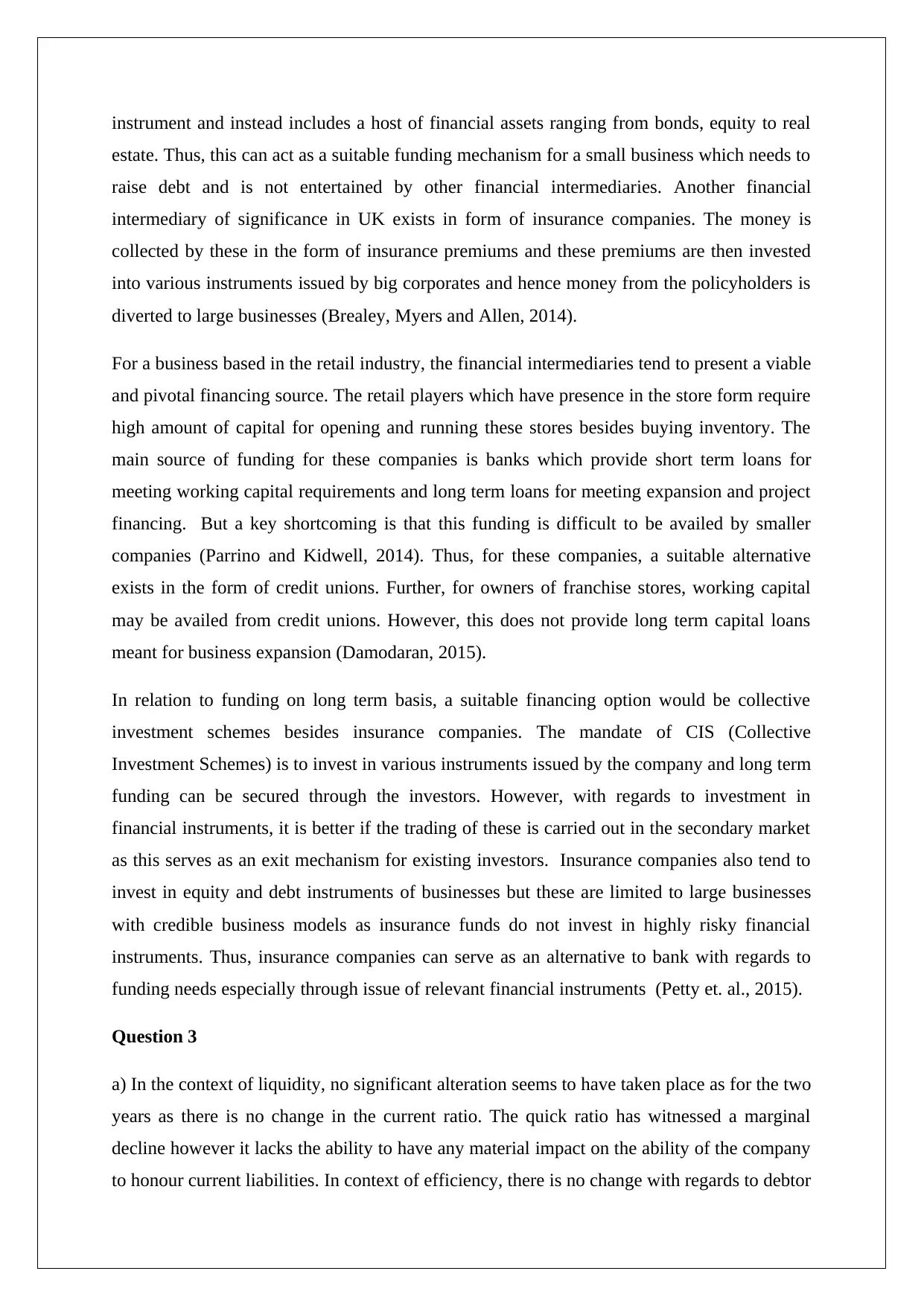
instrument and instead includes a host of financial assets ranging from bonds, equity to real
estate. Thus, this can act as a suitable funding mechanism for a small business which needs to
raise debt and is not entertained by other financial intermediaries. Another financial
intermediary of significance in UK exists in form of insurance companies. The money is
collected by these in the form of insurance premiums and these premiums are then invested
into various instruments issued by big corporates and hence money from the policyholders is
diverted to large businesses (Brealey, Myers and Allen, 2014).
For a business based in the retail industry, the financial intermediaries tend to present a viable
and pivotal financing source. The retail players which have presence in the store form require
high amount of capital for opening and running these stores besides buying inventory. The
main source of funding for these companies is banks which provide short term loans for
meeting working capital requirements and long term loans for meeting expansion and project
financing. But a key shortcoming is that this funding is difficult to be availed by smaller
companies (Parrino and Kidwell, 2014). Thus, for these companies, a suitable alternative
exists in the form of credit unions. Further, for owners of franchise stores, working capital
may be availed from credit unions. However, this does not provide long term capital loans
meant for business expansion (Damodaran, 2015).
In relation to funding on long term basis, a suitable financing option would be collective
investment schemes besides insurance companies. The mandate of CIS (Collective
Investment Schemes) is to invest in various instruments issued by the company and long term
funding can be secured through the investors. However, with regards to investment in
financial instruments, it is better if the trading of these is carried out in the secondary market
as this serves as an exit mechanism for existing investors. Insurance companies also tend to
invest in equity and debt instruments of businesses but these are limited to large businesses
with credible business models as insurance funds do not invest in highly risky financial
instruments. Thus, insurance companies can serve as an alternative to bank with regards to
funding needs especially through issue of relevant financial instruments (Petty et. al., 2015).
Question 3
a) In the context of liquidity, no significant alteration seems to have taken place as for the two
years as there is no change in the current ratio. The quick ratio has witnessed a marginal
decline however it lacks the ability to have any material impact on the ability of the company
to honour current liabilities. In context of efficiency, there is no change with regards to debtor
estate. Thus, this can act as a suitable funding mechanism for a small business which needs to
raise debt and is not entertained by other financial intermediaries. Another financial
intermediary of significance in UK exists in form of insurance companies. The money is
collected by these in the form of insurance premiums and these premiums are then invested
into various instruments issued by big corporates and hence money from the policyholders is
diverted to large businesses (Brealey, Myers and Allen, 2014).
For a business based in the retail industry, the financial intermediaries tend to present a viable
and pivotal financing source. The retail players which have presence in the store form require
high amount of capital for opening and running these stores besides buying inventory. The
main source of funding for these companies is banks which provide short term loans for
meeting working capital requirements and long term loans for meeting expansion and project
financing. But a key shortcoming is that this funding is difficult to be availed by smaller
companies (Parrino and Kidwell, 2014). Thus, for these companies, a suitable alternative
exists in the form of credit unions. Further, for owners of franchise stores, working capital
may be availed from credit unions. However, this does not provide long term capital loans
meant for business expansion (Damodaran, 2015).
In relation to funding on long term basis, a suitable financing option would be collective
investment schemes besides insurance companies. The mandate of CIS (Collective
Investment Schemes) is to invest in various instruments issued by the company and long term
funding can be secured through the investors. However, with regards to investment in
financial instruments, it is better if the trading of these is carried out in the secondary market
as this serves as an exit mechanism for existing investors. Insurance companies also tend to
invest in equity and debt instruments of businesses but these are limited to large businesses
with credible business models as insurance funds do not invest in highly risky financial
instruments. Thus, insurance companies can serve as an alternative to bank with regards to
funding needs especially through issue of relevant financial instruments (Petty et. al., 2015).
Question 3
a) In the context of liquidity, no significant alteration seems to have taken place as for the two
years as there is no change in the current ratio. The quick ratio has witnessed a marginal
decline however it lacks the ability to have any material impact on the ability of the company
to honour current liabilities. In context of efficiency, there is no change with regards to debtor
Paraphrase This Document
Need a fresh take? Get an instant paraphrase of this document with our AI Paraphraser
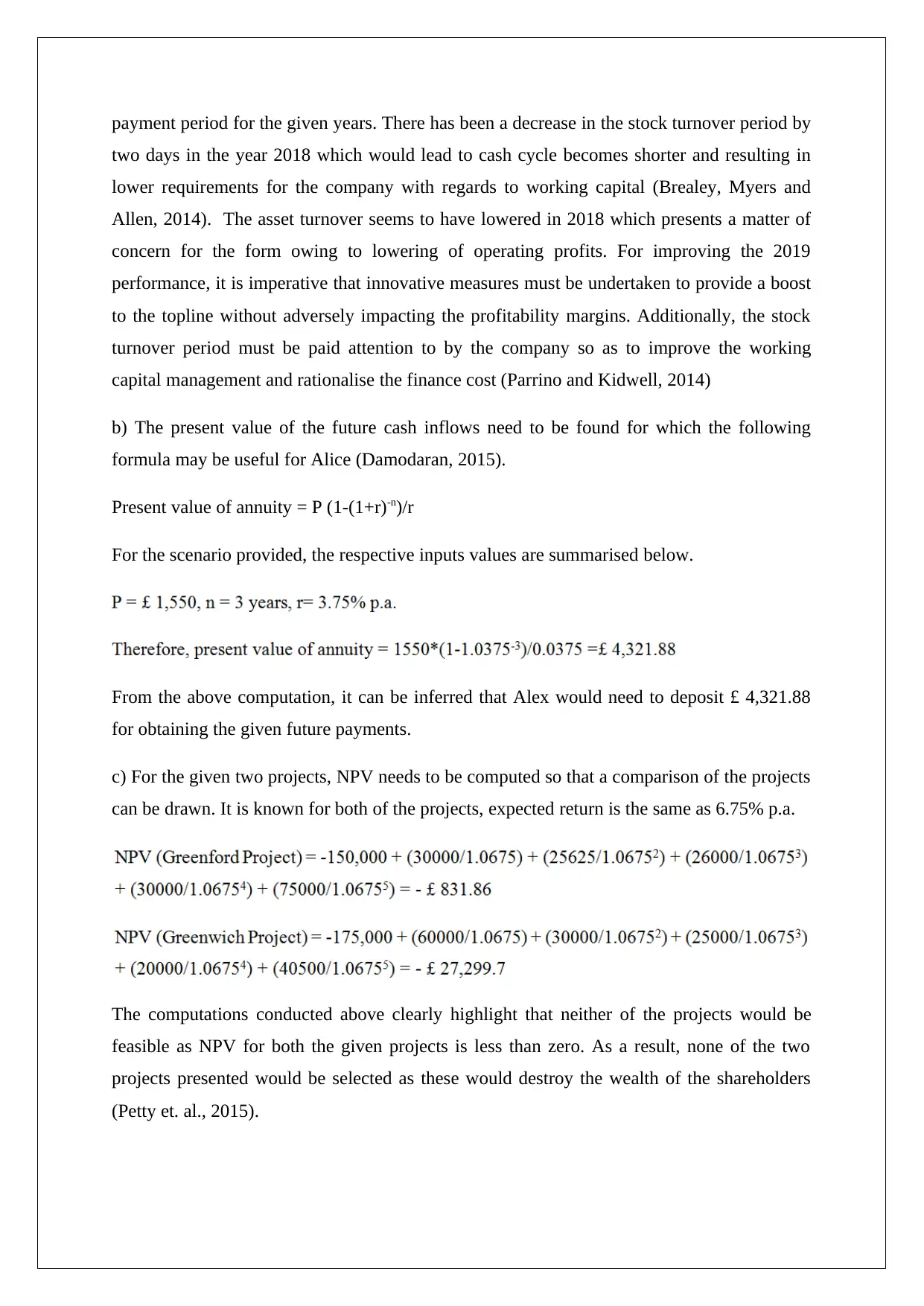
payment period for the given years. There has been a decrease in the stock turnover period by
two days in the year 2018 which would lead to cash cycle becomes shorter and resulting in
lower requirements for the company with regards to working capital (Brealey, Myers and
Allen, 2014). The asset turnover seems to have lowered in 2018 which presents a matter of
concern for the form owing to lowering of operating profits. For improving the 2019
performance, it is imperative that innovative measures must be undertaken to provide a boost
to the topline without adversely impacting the profitability margins. Additionally, the stock
turnover period must be paid attention to by the company so as to improve the working
capital management and rationalise the finance cost (Parrino and Kidwell, 2014)
b) The present value of the future cash inflows need to be found for which the following
formula may be useful for Alice (Damodaran, 2015).
Present value of annuity = P (1-(1+r)-n)/r
For the scenario provided, the respective inputs values are summarised below.
From the above computation, it can be inferred that Alex would need to deposit £ 4,321.88
for obtaining the given future payments.
c) For the given two projects, NPV needs to be computed so that a comparison of the projects
can be drawn. It is known for both of the projects, expected return is the same as 6.75% p.a.
The computations conducted above clearly highlight that neither of the projects would be
feasible as NPV for both the given projects is less than zero. As a result, none of the two
projects presented would be selected as these would destroy the wealth of the shareholders
(Petty et. al., 2015).
two days in the year 2018 which would lead to cash cycle becomes shorter and resulting in
lower requirements for the company with regards to working capital (Brealey, Myers and
Allen, 2014). The asset turnover seems to have lowered in 2018 which presents a matter of
concern for the form owing to lowering of operating profits. For improving the 2019
performance, it is imperative that innovative measures must be undertaken to provide a boost
to the topline without adversely impacting the profitability margins. Additionally, the stock
turnover period must be paid attention to by the company so as to improve the working
capital management and rationalise the finance cost (Parrino and Kidwell, 2014)
b) The present value of the future cash inflows need to be found for which the following
formula may be useful for Alice (Damodaran, 2015).
Present value of annuity = P (1-(1+r)-n)/r
For the scenario provided, the respective inputs values are summarised below.
From the above computation, it can be inferred that Alex would need to deposit £ 4,321.88
for obtaining the given future payments.
c) For the given two projects, NPV needs to be computed so that a comparison of the projects
can be drawn. It is known for both of the projects, expected return is the same as 6.75% p.a.
The computations conducted above clearly highlight that neither of the projects would be
feasible as NPV for both the given projects is less than zero. As a result, none of the two
projects presented would be selected as these would destroy the wealth of the shareholders
(Petty et. al., 2015).
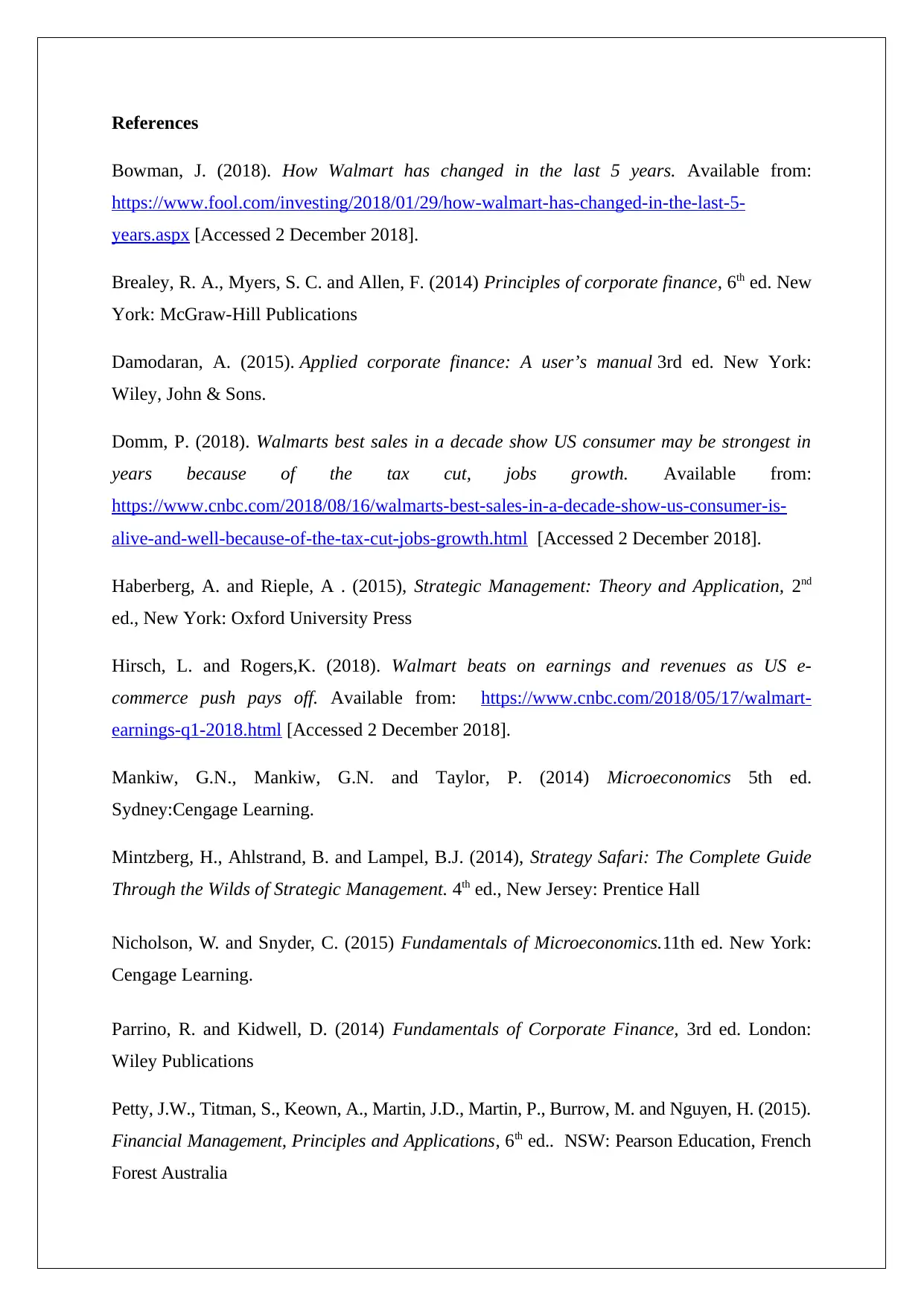
References
Bowman, J. (2018). How Walmart has changed in the last 5 years. Available from:
https://www.fool.com/investing/2018/01/29/how-walmart-has-changed-in-the-last-5-
years.aspx [Accessed 2 December 2018].
Brealey, R. A., Myers, S. C. and Allen, F. (2014) Principles of corporate finance, 6th ed. New
York: McGraw-Hill Publications
Damodaran, A. (2015). Applied corporate finance: A user’s manual 3rd ed. New York:
Wiley, John & Sons.
Domm, P. (2018). Walmarts best sales in a decade show US consumer may be strongest in
years because of the tax cut, jobs growth. Available from:
https://www.cnbc.com/2018/08/16/walmarts-best-sales-in-a-decade-show-us-consumer-is-
alive-and-well-because-of-the-tax-cut-jobs-growth.html [Accessed 2 December 2018].
Haberberg, A. and Rieple, A . (2015), Strategic Management: Theory and Application, 2nd
ed., New York: Oxford University Press
Hirsch, L. and Rogers,K. (2018). Walmart beats on earnings and revenues as US e-
commerce push pays off. Available from: https://www.cnbc.com/2018/05/17/walmart-
earnings-q1-2018.html [Accessed 2 December 2018].
Mankiw, G.N., Mankiw, G.N. and Taylor, P. (2014) Microeconomics 5th ed.
Sydney:Cengage Learning.
Mintzberg, H., Ahlstrand, B. and Lampel, B.J. (2014), Strategy Safari: The Complete Guide
Through the Wilds of Strategic Management. 4th ed., New Jersey: Prentice Hall
Nicholson, W. and Snyder, C. (2015) Fundamentals of Microeconomics.11th ed. New York:
Cengage Learning.
Parrino, R. and Kidwell, D. (2014) Fundamentals of Corporate Finance, 3rd ed. London:
Wiley Publications
Petty, J.W., Titman, S., Keown, A., Martin, J.D., Martin, P., Burrow, M. and Nguyen, H. (2015).
Financial Management, Principles and Applications, 6th ed.. NSW: Pearson Education, French
Forest Australia
Bowman, J. (2018). How Walmart has changed in the last 5 years. Available from:
https://www.fool.com/investing/2018/01/29/how-walmart-has-changed-in-the-last-5-
years.aspx [Accessed 2 December 2018].
Brealey, R. A., Myers, S. C. and Allen, F. (2014) Principles of corporate finance, 6th ed. New
York: McGraw-Hill Publications
Damodaran, A. (2015). Applied corporate finance: A user’s manual 3rd ed. New York:
Wiley, John & Sons.
Domm, P. (2018). Walmarts best sales in a decade show US consumer may be strongest in
years because of the tax cut, jobs growth. Available from:
https://www.cnbc.com/2018/08/16/walmarts-best-sales-in-a-decade-show-us-consumer-is-
alive-and-well-because-of-the-tax-cut-jobs-growth.html [Accessed 2 December 2018].
Haberberg, A. and Rieple, A . (2015), Strategic Management: Theory and Application, 2nd
ed., New York: Oxford University Press
Hirsch, L. and Rogers,K. (2018). Walmart beats on earnings and revenues as US e-
commerce push pays off. Available from: https://www.cnbc.com/2018/05/17/walmart-
earnings-q1-2018.html [Accessed 2 December 2018].
Mankiw, G.N., Mankiw, G.N. and Taylor, P. (2014) Microeconomics 5th ed.
Sydney:Cengage Learning.
Mintzberg, H., Ahlstrand, B. and Lampel, B.J. (2014), Strategy Safari: The Complete Guide
Through the Wilds of Strategic Management. 4th ed., New Jersey: Prentice Hall
Nicholson, W. and Snyder, C. (2015) Fundamentals of Microeconomics.11th ed. New York:
Cengage Learning.
Parrino, R. and Kidwell, D. (2014) Fundamentals of Corporate Finance, 3rd ed. London:
Wiley Publications
Petty, J.W., Titman, S., Keown, A., Martin, J.D., Martin, P., Burrow, M. and Nguyen, H. (2015).
Financial Management, Principles and Applications, 6th ed.. NSW: Pearson Education, French
Forest Australia
⊘ This is a preview!⊘
Do you want full access?
Subscribe today to unlock all pages.

Trusted by 1+ million students worldwide
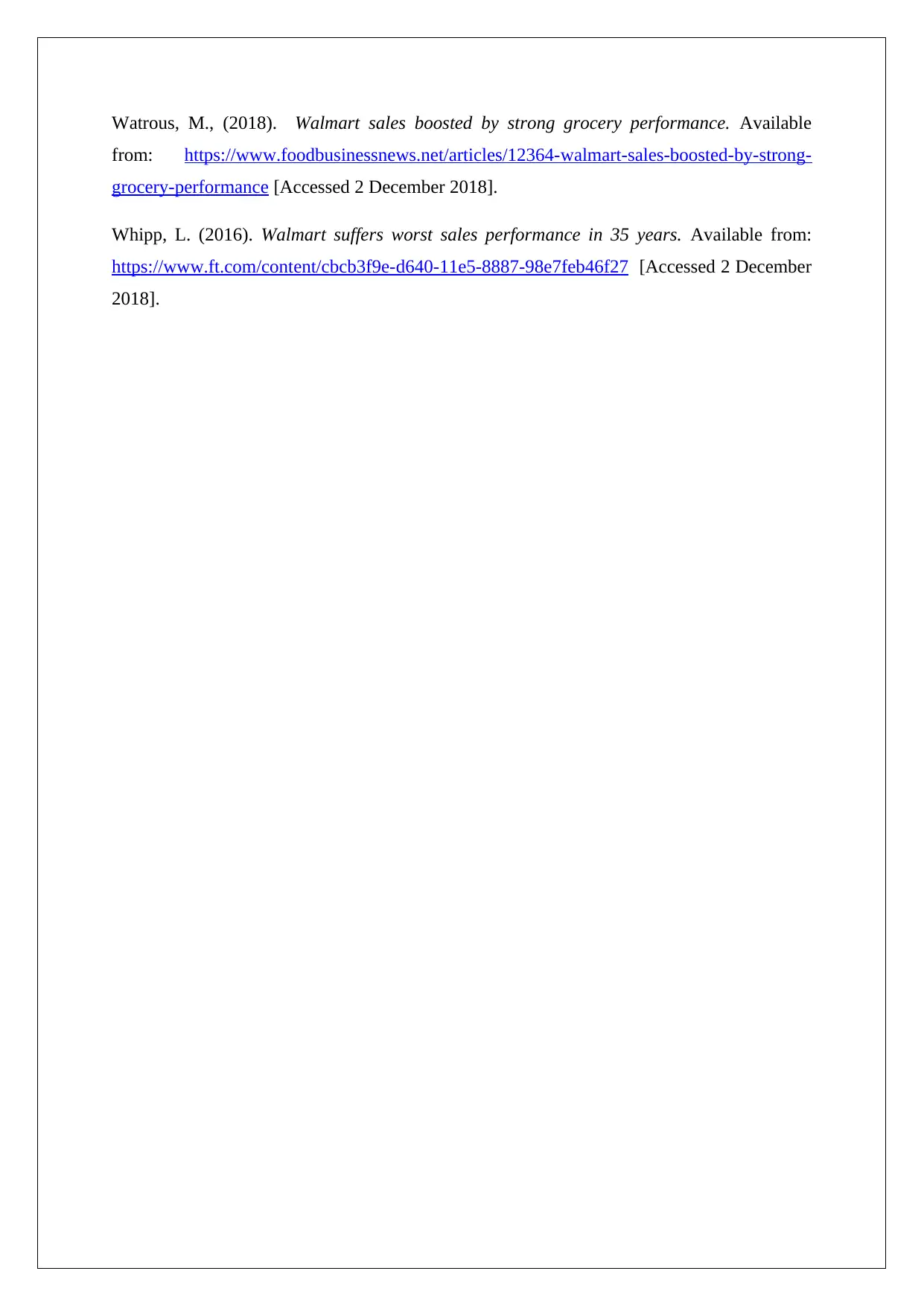
Watrous, M., (2018). Walmart sales boosted by strong grocery performance. Available
from: https://www.foodbusinessnews.net/articles/12364-walmart-sales-boosted-by-strong-
grocery-performance [Accessed 2 December 2018].
Whipp, L. (2016). Walmart suffers worst sales performance in 35 years. Available from:
https://www.ft.com/content/cbcb3f9e-d640-11e5-8887-98e7feb46f27 [Accessed 2 December
2018].
from: https://www.foodbusinessnews.net/articles/12364-walmart-sales-boosted-by-strong-
grocery-performance [Accessed 2 December 2018].
Whipp, L. (2016). Walmart suffers worst sales performance in 35 years. Available from:
https://www.ft.com/content/cbcb3f9e-d640-11e5-8887-98e7feb46f27 [Accessed 2 December
2018].
1 out of 10
Related Documents
Your All-in-One AI-Powered Toolkit for Academic Success.
+13062052269
info@desklib.com
Available 24*7 on WhatsApp / Email
![[object Object]](/_next/static/media/star-bottom.7253800d.svg)
Unlock your academic potential
Copyright © 2020–2025 A2Z Services. All Rights Reserved. Developed and managed by ZUCOL.



